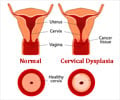
‘Effectiveness of radiation therapy (RT) for cervical cancer may be evaluated with the help of nanoparticles. This may help assess the effectiveness of radiation therapy and predict the recovery period in patients.
’
Tweet it Now
The increase in the relapse rate of cancer challenges the effectiveness of radiation therapy. It is thus crucial to develop suitable diagnostics for early treatment. Diagnostic method for Cervical Cancer
The study team has developed a scanning electron microscopy (SEM) that can be used to analyze the changes in the morphology of blood cells – erythrocytes during radiation therapy. This allows detailed viewing of the cellular morphology (extracellular vesicles), along with the number and size of nanoparticles found on their surface at different stages of RT.
The method thereby helps assess the effectiveness of radiation therapy and predict the recovery period. The efficacy of the diagnostic method was validated through the venous blood samples collected from cervical cancer patients.
“It is known that erythrocytes carry gases (oxygen, nitric oxide, etc.), and also have receptors for a number of hormones and mediators (insulin-like growth factor, ATP) necessary for the regulation of the body’s vital functions. We discovered another mechanism: along with erythrocytes, nanosized vesicles and other nanoparticles that appear on the surface of erythrocytes as a result of the pathology can also spread throughout the body. For example, the presence of such nanosized particles in human blood may indicate the development of cancer. By analyzing changes in the morphology and composition of nanoscale vesicles, one can monitor the effectiveness of radiation therapy,” says Prof. Grigory Maksimov, NUST MISIS.
Advertisement
Source-Medindia















